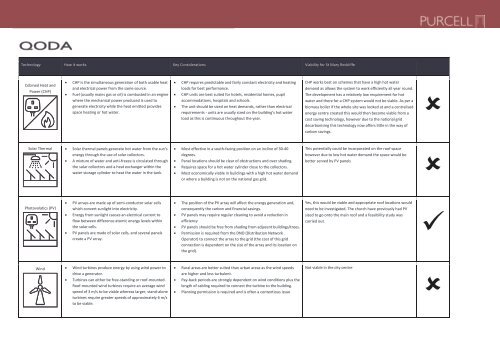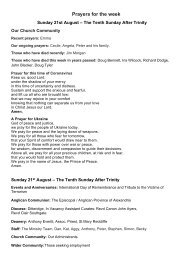St Mary Redcliffe Project 450 RIBA 2 Stage End Report
You also want an ePaper? Increase the reach of your titles
YUMPU automatically turns print PDFs into web optimized ePapers that Google loves.
1563.R1 – <strong>St</strong>age 2 report Page 12 of 29<br />
Technology How it works Key Considerations Viability for <strong>St</strong> <strong>Mary</strong> <strong>Redcliffe</strong><br />
Cobined Heat and<br />
Power (CHP)<br />
• CHP is the simultaneous generation of both usable heat<br />
and electrical power from the same source.<br />
• Fuel (usually mains gas or oil) is combusted in an engine<br />
where the mechanical power produced is used to<br />
generate electricity while the heat emitted provides<br />
space heating or hot water.<br />
• CHP requires predictable and fairly constant electricity and heating<br />
loads for best performance.<br />
• CHP units are best suited for hotels, residential homes, pupil<br />
accommodations, hospitals and schools.<br />
• The unit should be sized on heat demands, rather than electrical<br />
requirements - units are usually sized on the building’s hot water<br />
load as this is continuous throughout the year.<br />
CHP works best on schemes that have a high hot water<br />
demand as allows the system to work efficiently all year round.<br />
The development has a relatively low requirement for hot<br />
water and there for a CHP system would not be viable. As per a<br />
biomass boiler if the whole site was looked at and a centralised<br />
energy centre created this would then become viable from a<br />
cost saving technology, however due to the national grid<br />
<br />
decarbonising this technology now offers little in the way of<br />
carbon savings.<br />
Solar Thermal • Solar thermal panels generate hot water from the sun’s<br />
energy through the use of solar collectors.<br />
• A mixture of water and anti-freeze is circulated through<br />
the solar collectors and a heat exchanger within the<br />
water storage cylinder to heat the water in the tank.<br />
• Most effective in a south-facing position on an incline of 30-40<br />
degrees.<br />
• Panel locations should be clear of obstructions and over shading.<br />
• Requires space for a hot water cylinder close to the collectors.<br />
• Most economically viable in buildings with a high hot water demand<br />
or where a building is not on the national gas grid.<br />
This potentially could be incorporated on the roof space<br />
however due to low hot water demand the space would be<br />
better served by PV panels<br />
<br />
Photovolatics (PV)<br />
• PV arrays are made up of semi-conductor solar cells<br />
which convert sunlight into electricity.<br />
• The position of the PV array will affect the energy generation and,<br />
consequently the carbon and financial savings.<br />
Yes, this would be viable and appropriate roof locations would<br />
need to be investigated. The church have previously had PV<br />
• Energy from sunlight causes an electrical current to<br />
flow between difference atomic energy levels within<br />
the solar cells.<br />
• PV panels may require regular cleaning to avoid a reduction in<br />
efficiency<br />
• PV panels should be free from shading from adjacent buildings/trees.<br />
sized to go onto the main roof and a feasibility study was<br />
carried out.<br />
✓<br />
• PV panels are made of solar cells, and several panels<br />
create a PV array.<br />
• Permission is required from the DNO (Distribution Network<br />
Operator) to connect the array to the grid (the cost of this grid<br />
connection is dependent on the size of the array and its location on<br />
the grid).<br />
Wind • Wind turbines produce energy by using wind power to<br />
drive a generator.<br />
• Turbines can either be free-standing or roof-mounted.<br />
Roof-mounted wind turbines require an average wind<br />
speed of 3 m/s to be viable whereas larger, stand-alone<br />
turbines require greater speeds of approximately 6 m/s<br />
to be viable.<br />
• Rural areas are better suited than urban areas as the wind speeds<br />
are higher and less turbulent.<br />
• Pay-back periods are strongly dependent on wind conditions plus the<br />
length of cabling required to connect the turbine to the building.<br />
• Planning permission is required and is often a contentious issue<br />
Not viable in the city centre


















